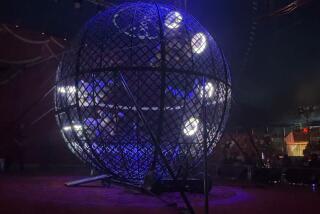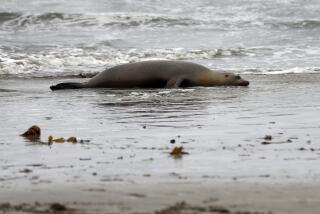Where captives put on a show
- Share via
The whale and dolphin shows I saw at SeaWorld in San Diego a couple of years ago with my wife and daughter weren’t just good, they were spectacular. I think that’s one reason they gave me the creeps.
The more amazing the stunts were, with super-intelligent mammals performing circus tricks for us humans, the dumber I felt.
I had subjected my daughter to a contrived spectacle, just a mile from the natural wonders of the open sea. Did I really want her to think that wild animals exist for our amusement, or that it’s OK to ride a killer whale as if it were a pony?
Soon after, I talked about it with my cousin, a marine biologist.
The general rationalization by marine parks, he said, is that the shows raise public interest in the mammals and enhance conservation efforts.
But those claims strike me as dubious after the death last week of an Orlando SeaWorld trainer who was grabbed by the ponytail and killed by a killer whale before an audience.
The same killer whale had been involved in two other deaths, and orca shows were temporarily halted in Orlando and San Diego. Now officials are investigating the death and prior incidents in Orlando, even as the shows have resumed and crowds have returned.
“We stand very strongly behind the fact, and our surveys bear this out, that people are coming here and gaining a greater appreciation for these animals and the ocean environments they live in,” said Dave Koontz, a San Diego SeaWorld spokesman.
“The fact that they have an opportunity to see these animals in person makes a huge difference,” he says.
But aren’t they seeing something artificial?
“We don’t feel that there’s anything about it that’s artificial at all,” Koontz told me.
I don’t think he was kidding.
Look, I’d agree that many of the exhibits at the San Diego marine park are legitimate educational tools -- although if you want to really learn something about sea creatures, you’re far better off going to the Aquarium of the Pacific in Long Beach or the Monterey Bay Aquarium.
But the big draws at parks like those in the SeaWorld chain, which was just bought for $2.7 billion, are the killer whale and dolphin shows.
It’s not about education, it’s about big business, says Ric O’Barry, who you may have seen in “The Cove,” the Oscar-nominated documentary that exposed the secret slaughter of thousands of dolphins in Japan -- and how a few of the most beautiful mammals are spared and sold to marine parks.
“It’s a form of bad education,” O’Barry says of theme park shows. “There’s no connection between conservation and stupid dolphin tricks.”
O’Barry traveled a long way to get to that point of view. He caught and trained the dolphins used on the TV show “Flipper,” and he has been credited with training one of the first killer whales used in a show.
“I was as ignorant as I could be for as long as could be, and I was making a lot of money,” says O’Barry, who told me he used to lug a television down to the docks “so Flipper could watch himself on TV on Friday nights at 7:30.”
O’Barry says he eventually learned enough about the mammals, which depend on sound waves to navigate, to know they were suffering in captivity, subjected to unnatural confines and bombarded by noise for the sake of human entertainment.
He believes that one of the dolphins used in “Flipper” committed suicide by refusing to come up for air.
“I got tired of being a professional liar,” O’Barry says. “You have to lie about education and research.”
If you go to the San Diego Zoo, he said, you’ll note that a snake at least has a relatively natural habitat.
“There’s some grass and tree limbs, and he can climb under rocks to get away from the public. If you go to SeaWorld and put your head under the water and look around, there’s a concrete box,” O’Barry says.
Gwen Goodmanlowe, a marine biology lecturer at Cal State Long Beach, says there is some legitimate research at SeaWorld.
“But I don’t think there’s enough to counteract the captivity,” she adds, arguing that killer whales can travel hundreds of miles daily in the ocean. She thinks it’s cruel to confine them to small enclosures.
J. William Gibson, author of “A Reenchanted World: The Quest for a New Kinship With Nature,” says he thinks O’Barry’s evolution and my own regret about taking my daughter to SeaWorld are part of a movement toward a human relationship with nature that’s more harmonious and less dominating.
To put it another way, Gibson says watching captive whales and dolphins perform is “not a good way for us to express our appreciation of wild animals.”
If you want a more natural experience than, say, Dine With Shamu, hook up with Heal the Bay for a whale-watching adventure on Santa Monica Bay.
Or go to the beach and wait for the dolphins to come by.
For me, seeing them in their element is an unbeatable show filled with mystery and wonder, and admission is free.
More to Read
Sign up for The Wild
We’ll help you find the best places to hike, bike and run, as well as the perfect silent spots for meditation and yoga.
You may occasionally receive promotional content from the Los Angeles Times.







